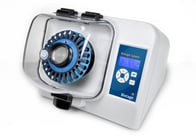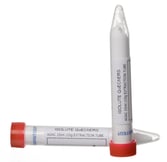Apr 3, 2023 11:56:03 AM
What Exactly is QuEChERS and How is it an Extraction?
By Deanna Bissonnette

You might be saying to yourself, QuEChERS isn’t an extraction, it’s just QuEChERS! I know when I think extraction, I think of your traditional liquid-liquid or solid-phase extraction where you have a water sample that you’re trying to measure contamination levels within (if any of course). In a sense, QuEChERS extractions are very similar to a liquid-liquid extraction though, it’s just that instead of a water sample (liquid), you have your food or plant material sample (solid). It really is just a solid-liquid extraction.
Before we dive deep into this extraction process for QuEChERS, I just wanted to clear up what QuEChERS really is because I think sometimes, we forget (I know I do). It has become a very marketable term, but really it is an acronym. As long as your process follows the protocol of Quick, Easy, Cheap, Effective Rugged, and Safe, then you have yourself a QuEChERS approach!
Now that we’ve got the definition squared away, it’s time to get to the meat (or plants)! So, how does this extraction for QuEChERS work exactly?.jpg?width=185&height=123&name=7458%20(1).jpg) Well, say you have this plant material and you’re trying to measure to see if there are pesticides in it. How do you do that? We can’t just put solvent in with the plants and let it sit because there is no agitation or lysing of the cells. If perhaps it did work by just letting the sample sit and soak in solvent, it would take FOREVER. We are all about being “Quick” when it comes to QuEChERs right? So, we want to make sure we agitate and lyse our samples so we can break apart those cells and material to get to the inside parts of the sample and allow that solvent to soak and grab those analytes of interest for analysis.
Well, say you have this plant material and you’re trying to measure to see if there are pesticides in it. How do you do that? We can’t just put solvent in with the plants and let it sit because there is no agitation or lysing of the cells. If perhaps it did work by just letting the sample sit and soak in solvent, it would take FOREVER. We are all about being “Quick” when it comes to QuEChERs right? So, we want to make sure we agitate and lyse our samples so we can break apart those cells and material to get to the inside parts of the sample and allow that solvent to soak and grab those analytes of interest for analysis.
Okay, that makes sense, right? What can I use to lyse my samples then? I am so glad you asked! The Biotage® Lysera is a really great tool thatcan handle many different complex matrices. To grind and lyse your samples with the Lysera, you will need to put your sample into a tube with some beads. The type and size beads as well as tube size would be sample dependent, so check out this blog on the differences between bead mill homogenizers and blenders.
Next, you’ll need to add your solvent. This will mix around with the sample and beads to extract those analytes of interest from within your-1.jpg?width=210&height=160&name=19-640a%20(002)-1.jpg) plant material, for example. The most common solvent used for this step is acetonitrile, and most of the time there is a special mixture of salts required to ensure the pesticides get pushed from that original solid phase to the liquid phase (acetonitrile). If you are working with the AOAC protocol, then you would be working with relatively strong acetate buffer conditions (pH 4.8 or so). For the EN protocol, you would be working with weaker citrate buffer conditions (pH 5.0-5.5 or so). The pH level is super important for the extraction because if you have a pH closer to 5, recoveries for pH dependent analytes (i.e. pymetrozine, imazalil, and thiabendazole) should recover over 70%.
plant material, for example. The most common solvent used for this step is acetonitrile, and most of the time there is a special mixture of salts required to ensure the pesticides get pushed from that original solid phase to the liquid phase (acetonitrile). If you are working with the AOAC protocol, then you would be working with relatively strong acetate buffer conditions (pH 4.8 or so). For the EN protocol, you would be working with weaker citrate buffer conditions (pH 5.0-5.5 or so). The pH level is super important for the extraction because if you have a pH closer to 5, recoveries for pH dependent analytes (i.e. pymetrozine, imazalil, and thiabendazole) should recover over 70%.
Now that you’ve homogenized and added your salts, you’ll need to get the residual solid particles separated from your liquid phase. You caneither let your sample settle post homogenization, but again QuEChERS is supposed to be “Quick”, so you’ll want to centrifuge your samples to have a clear separation of the original plant material, for example, and solvent which is where your analytes of interest are hanging out.
caneither let your sample settle post homogenization, but again QuEChERS is supposed to be “Quick”, so you’ll want to centrifuge your samples to have a clear separation of the original plant material, for example, and solvent which is where your analytes of interest are hanging out.
There you have it! A QuEChERS extraction! Yup, that is it for the extraction part, but there is another part that you need to do to your samples before analysis. Remember, you have to clean-up those extracts (and maybe even concentrate depending on sensitivity requirements) prior to analysis. That homogenization step does a really good job of extracting your analytes, but it also does an excellent job of extracting matrix interferences. We want to make sure that we have “Effective” results from our extract analysis.
To learn more about QuEChERS sample preparation for food & agricultural matrices download the food analysis brochure.
Published: Apr 3, 2023 11:56:03 AM


